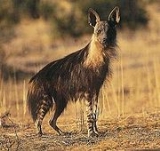
Hyaena
Encyclopedia
For the Siouxsie and the Banshees album, see Hyæna.
For the group of animals commonly known as "hyaena", see Hyena
.
Hyaena is a genus
comprising two of the living species
of hyena
s: the striped hyena
(Hyaena hyaena) from western Asia and northern Africa and the brown hyena
(Hyaena brunnea) from southern Africa
. The brown hyena has sometimes been placed in a separate genus Parahyaena, or even included in the otherwise fossil
genus Pachycrocuta
, but recent sources have tended to place it in Hyaena. The brown hyena's skull is larger than the striped hyena's skull. The male brown hyena is slightly larger than the female, while the sexes of the striped hyena are both the same size. Both species are smaller than the spotted hyena but larger than the aardwolf
. They are predominantly scavenger
s.
For the group of animals commonly known as "hyaena", see Hyena
Hyena
Hyenas or Hyaenas are the animals of the family Hyaenidae of suborder feliforms of the Carnivora. It is the fourth smallest biological family in the Carnivora , and one of the smallest in the mammalia...
.
Hyaena is a genus
Genus
In biology, a genus is a low-level taxonomic rank used in the biological classification of living and fossil organisms, which is an example of definition by genus and differentia...
comprising two of the living species
Species
In biology, a species is one of the basic units of biological classification and a taxonomic rank. A species is often defined as a group of organisms capable of interbreeding and producing fertile offspring. While in many cases this definition is adequate, more precise or differing measures are...
of hyena
Hyena
Hyenas or Hyaenas are the animals of the family Hyaenidae of suborder feliforms of the Carnivora. It is the fourth smallest biological family in the Carnivora , and one of the smallest in the mammalia...
s: the striped hyena
Striped Hyena
The Striped Hyena is a species of true hyena native to North and East Africa, the Caucasus, the Middle East, Middle and Central Asia and the Indian Subcontinent...
(Hyaena hyaena) from western Asia and northern Africa and the brown hyena
Brown Hyena
The brown hyena is a species of hyena which occurs in Namibia, Botswana, western and southern Zimbabwe, southern Mozambique and South Africa. It is currently the rarest hyena.-Description:...
(Hyaena brunnea) from southern Africa
Southern Africa
Southern Africa is the southernmost region of the African continent, variably defined by geography or geopolitics. Within the region are numerous territories, including the Republic of South Africa ; nowadays, the simpler term South Africa is generally reserved for the country in English.-UN...
. The brown hyena has sometimes been placed in a separate genus Parahyaena, or even included in the otherwise fossil
Fossil
Fossils are the preserved remains or traces of animals , plants, and other organisms from the remote past...
genus Pachycrocuta
Pachycrocuta
Pachycrocuta was a genus of prehistoric hyenas. The largest and most well-researched species was the giant hyena Pachycrocuta brevirostris, which stood about at the shoulder and may have weighed — the size of a lioness. This would make it the largest hyena to have ever lived. It lived between the...
, but recent sources have tended to place it in Hyaena. The brown hyena's skull is larger than the striped hyena's skull. The male brown hyena is slightly larger than the female, while the sexes of the striped hyena are both the same size. Both species are smaller than the spotted hyena but larger than the aardwolf
Aardwolf
The aardwolf is a small, insectivorous mammal, native to Eastern and Southern Africa. The name means "earth wolf" in Afrikaans/Dutch. It is also called "maanhaar jackal". It is related to hyenas, but unlike its relatives, it does not hunt large prey. This unusual animal preys on insects...
. They are predominantly scavenger
Scavenger
Scavenging is both a carnivorous and herbivorous feeding behavior in which individual scavengers search out dead animal and dead plant biomass on which to feed. The eating of carrion from the same species is referred to as cannibalism. Scavengers play an important role in the ecosystem by...
s.

